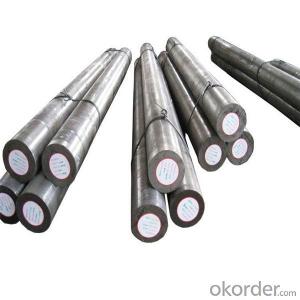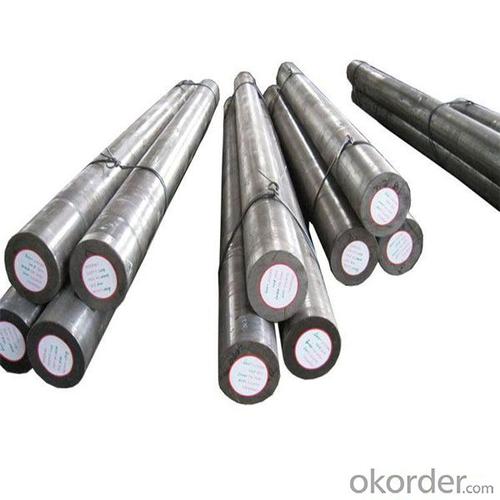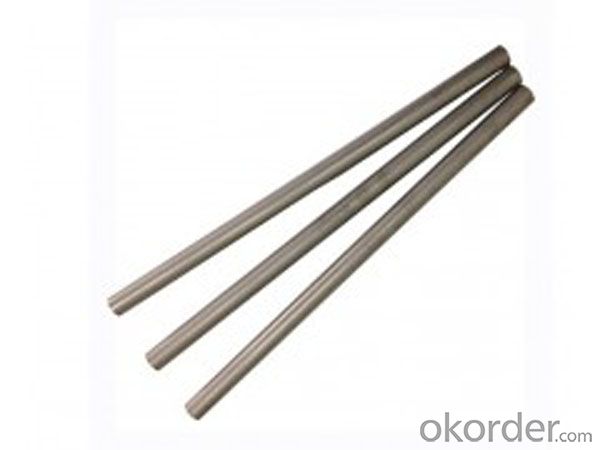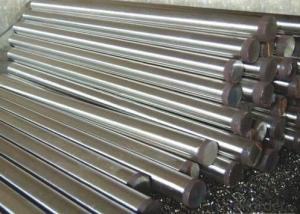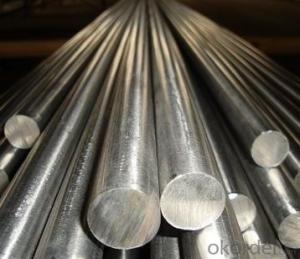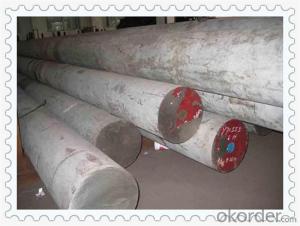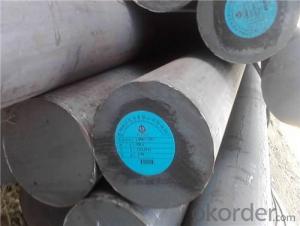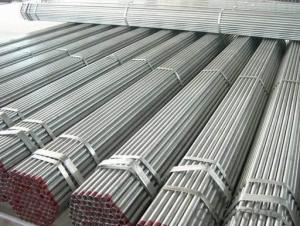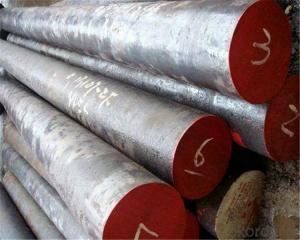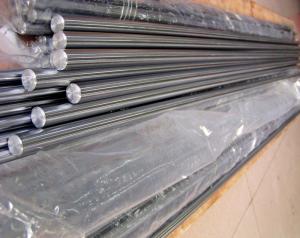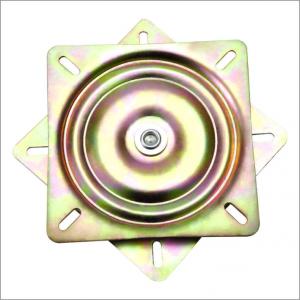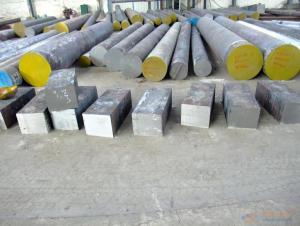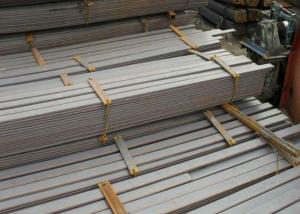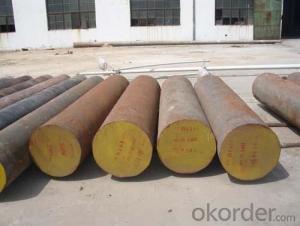SAE AISI ASTM 42CrMo4/4140 Alloy Steel Bar
- Loading Port:
- China main port
- Payment Terms:
- TT OR LC
- Min Order Qty:
- 30 m.t.
- Supply Capability:
- 10000 m.t./month
OKorder Service Pledge
OKorder Financial Service
You Might Also Like
Specification
SAE AISI ASTM 42CrMo4/4140 Alloy Steel Bar
Product Information:
1. Features Specifications: 42CrMo4 Alloy Steel Bar
2. Commodity: 42CrMo4 Alloy Steel Bar
Hot rolling craftwork and fine mechanical performance
Chemical components meet standards, delivery in black skin
3. Standards:
a) GB/T3077 42CrMo
b) JiS SCM440
c) Din 42CrMo4
d) ASTM 4140
4. Size: dia 12-160mm
5. Length:6M above
6. Packing:Bundles with iron wires
Product Overviews:
| Product Name | Typical Grades | Diameter(mm) | Standard adopted |
| Carbon Steel | 20 (1020/S20C/C22) | Ø16-Ø300 | GB/SAE/JIS/DIN |
| 40 (1040/S40C/C40) | |||
| 45 (1045/S45C/C45) | |||
| Bearing Steel | GCr9 (51100/SUJ1) | Ø12-Ø250 | |
| GCr15 (52100/SUJ2/100Gr6) | |||
| GCr9SiMn (A485-Gr.1/SUJ3) | |||
| Cr-Mo Steel | 20Cr (5120/SCr420H/20Cr4) | Ø12-Ø250 | |
| 40Cr (5140/SCr440/41Cr4) | |||
| 42CrMo(4140/SCM440/42CrMo4) | |||
| Gear Steel | 20CrNiMo | Ø16-Ø600 | |
| 20CrMn(5115/SMnC420/20MnCr5) | |||
| 20CrNiMo(8620/SNCM220/20CrMiMo2) |
Product Show:
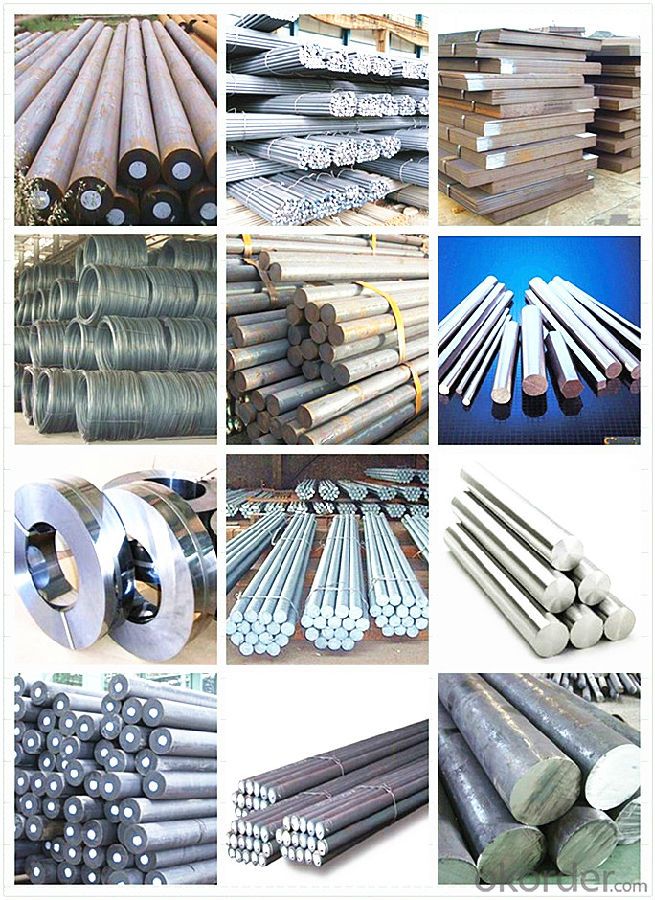
Our Advantages:
· Industry experience over 20 years.
· Shipment of goods -More than 70 countries worldwide.
· The most convenient transport and prompt delivery.
· Competitive price with best service.
· High technical production line with top quality products.
· High reputation based on best quality products.
With our experienced, enthusiastic and dynamic staffs, we assure to bring you the products with best quality, reasonable prices and good after-sales services under the motto: Friends First, Business After.
Communication, Experience, Expertise and Best efforts are our Promises to you.
- Q: Can special steel be used in the automotive parts manufacturing industry?
- Yes, special steel can be used in the automotive parts manufacturing industry. Special steel offers high strength, durability, and resistance to corrosion, making it suitable for various automotive components such as engine parts, suspension systems, and body structures. Additionally, special steel can be tailored to meet specific requirements, allowing manufacturers to optimize performance and safety in automotive applications.
- Q: What are the factors that affect the weldability of special steel?
- The factors that affect the weldability of special steel include composition, heat treatment, surface condition, joint design, welding process, and welding parameters.
- Q: What are the different heat treatment processes used in special steel production?
- Some of the different heat treatment processes used in special steel production include annealing, tempering, quenching, normalizing, and hardening.
- Q: What are the specific requirements for special steel used in nuclear applications?
- The specific requirements for special steel used in nuclear applications include high resistance to corrosion, excellent mechanical properties, and the ability to withstand high temperatures and neutron irradiation. Additionally, the steel must possess low levels of impurities and be highly resistant to embrittlement. It must also be capable of maintaining its integrity and structural stability over long periods of time, ensuring the safety and reliability of nuclear systems.
- Q: How does precipitation hardening enhance the strength of special steel?
- Precipitation hardening, also known as age hardening, is a heat treatment process that enhances the strength of special steel alloys. This process involves a series of steps that result in the formation of fine particles or precipitates within the material's microstructure. The strength of special steel is primarily determined by the arrangement and interaction of its atoms. In its initial state, the alloy's atoms are distributed randomly, resulting in a relatively soft and ductile material. However, through precipitation hardening, the formation of precipitates during heat treatment plays a crucial role in strengthening the steel. The process begins by heating the steel to a high temperature, known as solution treatment or aging temperature. This temperature allows the atoms to dissolve and form a solid solution. The alloy is then rapidly cooled to retain the supersaturated state of the solution. Following the rapid cooling, the steel is subjected to a lower temperature, known as aging temperature. At this stage, the dissolved atoms begin to migrate and cluster together, forming small precipitates within the material's microstructure. These precipitates act as obstacles to the movement of dislocations, which are the primary carriers of plastic deformation in metals. The presence of these precipitates hinders the dislocation movement, making it more difficult for them to glide through the crystal lattice. As a result, the strength of the steel is significantly enhanced. The dislocation obstacles provided by the precipitates increase the resistance to deformation, resulting in improved hardness and strength. Furthermore, the size, distribution, and homogeneity of the precipitates play a crucial role in determining the strength enhancement. Smaller and more uniform precipitates provide a higher density of obstacles, leading to a greater strengthening effect. Additionally, the precipitation hardening process also influences other material properties, such as corrosion resistance and toughness. In conclusion, precipitation hardening enhances the strength of special steel by creating fine precipitates within the material's microstructure. These precipitates act as obstacles to dislocation movement, increasing the resistance to deformation and resulting in improved hardness and strength. This heat treatment process plays a crucial role in the development of high-performance special steel alloys used in various industries.
- Q: How is corrosion-resistant stainless steel used in the production of marine equipment?
- Corrosion-resistant stainless steel is extensively used in the production of marine equipment due to its ability to withstand the harsh and corrosive marine environment. It is commonly utilized in the construction of ship hulls, propellers, valves, pumps, and various other components that are constantly exposed to saltwater and other corrosive elements. The stainless steel's resistance to corrosion helps to ensure the longevity and reliability of marine equipment, reducing maintenance and replacement costs, and contributing to the overall safety and efficiency of maritime operations.
- Q: How does special steel contribute to the chemical resistance of products?
- Special steel, also known as stainless steel, contributes significantly to the chemical resistance of products due to its unique composition and properties. These steels contain a high percentage of chromium, which forms a thin, passive oxide layer on the surface of the steel. This oxide layer acts as a protective barrier, preventing corrosive substances from coming into direct contact with the steel and causing chemical reactions. The chromium in special steel forms a stable oxide layer that is highly resistant to corrosion, even in harsh chemical environments. This oxide layer is self-repairing, meaning that if it is damaged or scratched, it will quickly reform and continue to protect the steel. Additionally, the presence of other alloying elements such as nickel and molybdenum further enhances the chemical resistance of special steel. The chemical resistance of special steel extends to a wide range of corrosive substances, including acids, alkalis, and salts. This makes it highly suitable for applications in various industries such as chemical processing, pharmaceuticals, food processing, and marine environments. By using special steel in the manufacturing of products, the risk of chemical degradation and corrosion is significantly reduced. This leads to increased product lifespan, improved performance, and reduced maintenance costs. Furthermore, it ensures that the integrity and safety of the products are maintained, as chemical resistance is crucial in preventing leaks, contamination, and structural failures. In summary, special steel contributes to the chemical resistance of products by forming a protective oxide layer on its surface, which shields it from corrosive substances. Its unique composition and properties make it highly resistant to chemical degradation, ensuring the longevity and reliability of products in various industrial applications.
- Q: What are the different methods for joining special steel?
- There are several methods available for joining special steel, which is typically used in applications that require high strength, corrosion resistance, or specific mechanical properties. Some of the most common methods for joining special steel include: 1. Welding: This is the most common method used to join special steel. Different types of welding techniques can be employed, such as arc welding (including shielded metal arc welding, gas metal arc welding, and flux-cored arc welding), resistance welding (spot welding, seam welding), and laser welding. Welding requires the use of filler material to bond the steel pieces together, and it can produce strong and durable joints. 2. Brazing: Brazing involves joining special steel using a filler material (typically a brass or bronze alloy) with a lower melting point than the base steel. The filler material is heated until it melts and flows into the joint, creating a strong bond. Brazing is often used for joining dissimilar metals or when the base steel has a high melting point. 3. Soldering: Similar to brazing, soldering also involves using a filler material with a lower melting point to join special steel. However, soldering typically uses a non-ferrous filler material, such as tin-lead or tin-silver alloys. Soldering is commonly used for joining electronic components or delicate parts that cannot withstand high temperatures. 4. Mechanical Fastening: Special steel can also be joined using mechanical fasteners, such as bolts, screws, rivets, or clips. This method is often used when the joint needs to be easily disassembled, or when welding or brazing is not feasible or desirable. 5. Adhesive Bonding: Adhesive bonding involves using a specialized adhesive or glue to join special steel. This method is suitable for joining thin or delicate steel components or when the joint requires high resistance to vibration or shock. Adhesive bonding can provide a strong and durable bond, but it may not be suitable for high-temperature or high-stress applications. It is important to consider the specific requirements of the application, such as strength, corrosion resistance, temperature resistance, and the desired permanence of the joint, when selecting the appropriate method for joining special steel. Each method has its own advantages and limitations, and choosing the right method will ensure a strong and reliable joint.
- Q: What are the different surface hardening grades of special steel?
- There are several surface hardening grades of special steel, including case-hardening steels such as 1018, 8620, and 8620H, which are commonly used for applications requiring a hard outer layer and a tough core. Another grade is nitriding steel, such as 4140, 4340, and 410, which are specifically designed for nitriding processes to improve wear resistance. Additionally, tool steels like D2, A2, and O1 are often used for surface hardening applications due to their high hardness and wear resistance properties. Overall, the choice of surface hardening grade depends on the specific requirements of the application.
- Q: What are the main factors affecting the fatigue strength of special steel?
- The main factors affecting the fatigue strength of special steel include the material's microstructure, surface condition, heat treatment, and loading conditions. Additionally, factors such as environmental conditions, stress concentration, and the presence of defects or imperfections can also influence the fatigue strength of special steel.
Send your message to us
SAE AISI ASTM 42CrMo4/4140 Alloy Steel Bar
- Loading Port:
- China main port
- Payment Terms:
- TT OR LC
- Min Order Qty:
- 30 m.t.
- Supply Capability:
- 10000 m.t./month
OKorder Service Pledge
OKorder Financial Service
Similar products
Hot products
Hot Searches
Related keywords
